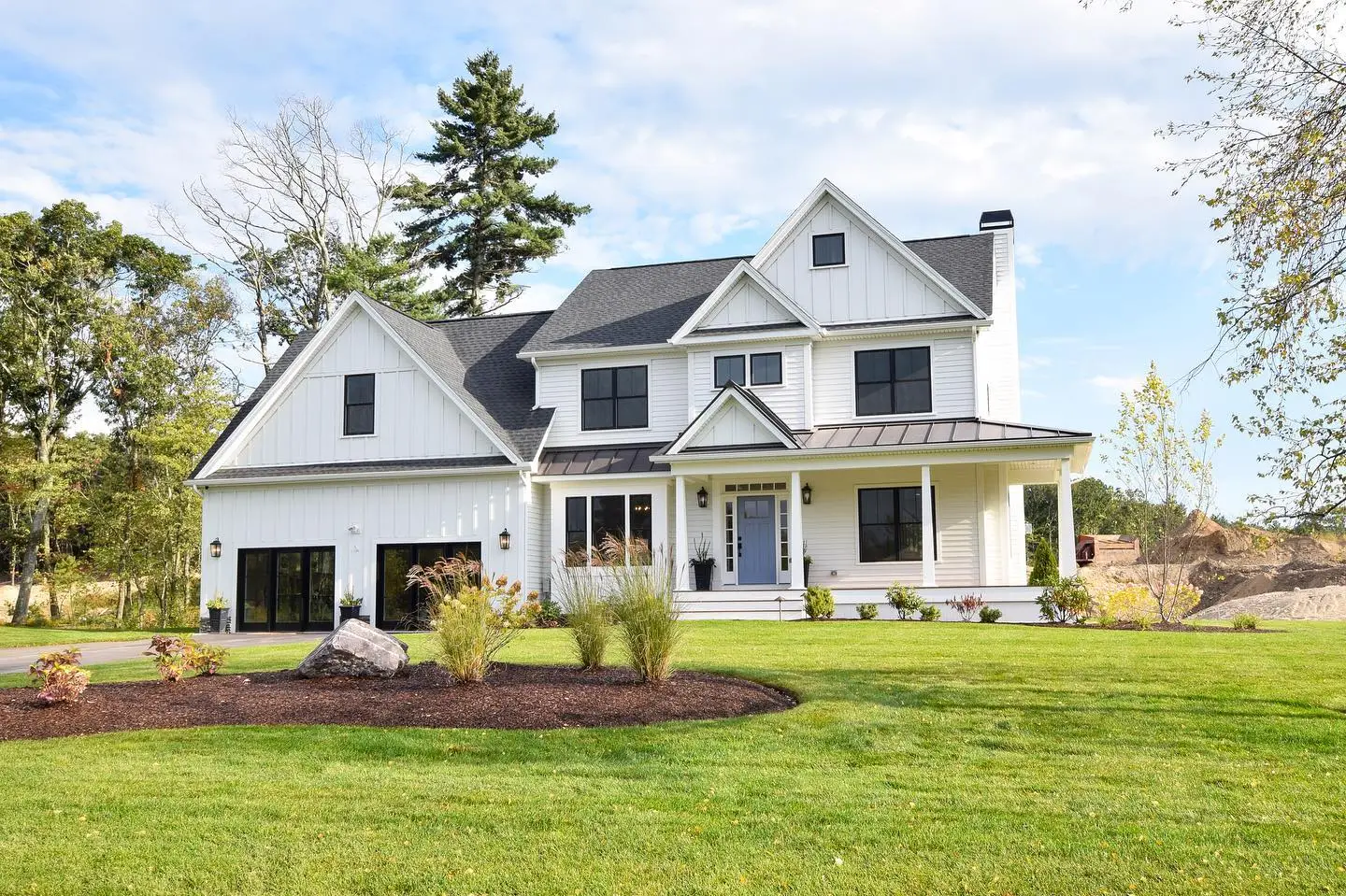What is the Best Siding for a House in New England? How Hardie®, Vinyl and Wood Stack Up
Table of Contents
How to Choose the Right Home Siding
Are you wondering how to choose the right home siding for your home? If you are replacing exterior siding, there are many different considerations to make. After all, knowing how to choose the right home siding will allow you to make the best investment possible!
When it comes to choosing siding, keep the following in mind:
Energy Savings
Choose energy-efficient siding that prevents heat transfer during the winter. This ensures that your home stays cozy during the coldest days–but it’ll also keep your home comfortable all year long. Keep in mind that outdated home siding can lose up to 25% of your home’s energy… so choose your new home siding wisely!
Styles and Profiles
One of the best and most exciting aspects of different kinds of house siding is customizing the appearance. There is a world of James Hardie® siding profiles as well as vinyl siding color options, including scallops, vinyl shake shingles, and traditional panels. There are also over 30 Hardie siding colors to explore along with over a dozen vinyl siding color options.
But how do you choose the right home siding for your home? With exterior siding installation, consider your home’s architecture and the age of your home. You can add architectural character with energy-efficient vinyl siding that looks like wood. Fiber cement siding also gives an organic yet timeless appearance. Coastal homes look great with Hardie® shingle siding or even energy-efficient vinyl siding.
If you’re looking to keep your home classic, consider James Hardie® plank siding or energy-efficient vinyl siding planks.
Maintenance
If you’re looking for home siding that doesn’t require much maintenance, there are two great options to consider: James Hardie® fiber cement and energy-efficient vinyl siding. Both are resistant to moisture damage and won’t rot away over the years, unlike wood. Energy-efficient vinyl siding and fiber cement can both be cleaned of atmospheric dirt with gentle cleaning solutions, following the manufacturer’s instructions.
Return on Investment
Get more for your investment by considering the return if you decide to sell. Luckily, both fiber cement and energy-efficient vinyl siding both have fantastic ROIs–with energy-efficient vinyl siding at 118% and Fiber Cement at 121%. These materials are a great investment for their home exterior remodel cost.
Lifespan
Lastly, you’ll want to consider the lifespan of your new home siding. High-quality energy-efficient vinyl siding and James Hardie® home siding can last for many decades!
 Choosing new home siding for your New England home often takes a lot of thought and care. The truth is that your cladding affects not just the aesthetic appeal of your property, but also its long-term performance. With New England’s ever-changing weather conditions, you’ll find three popular options at the forefront: James Hardie®, vinyl, and traditional wood siding. But what is the best siding for a house in New England?
While each material has its unique benefits, this blog will take a look at the key comparisons among them, focusing on why James Hardie® and energy-efficient vinyl siding often outperform wood in areas such as maintenance, cost-effectiveness, and resilience. Expect to talk about topics including energy-efficient siding, fire resistance, pest resistance, and maintenance.
From there, you can make your own decision on the best home siding for a house in New England–although we certainly have our favorites!
Choosing new home siding for your New England home often takes a lot of thought and care. The truth is that your cladding affects not just the aesthetic appeal of your property, but also its long-term performance. With New England’s ever-changing weather conditions, you’ll find three popular options at the forefront: James Hardie®, vinyl, and traditional wood siding. But what is the best siding for a house in New England?
While each material has its unique benefits, this blog will take a look at the key comparisons among them, focusing on why James Hardie® and energy-efficient vinyl siding often outperform wood in areas such as maintenance, cost-effectiveness, and resilience. Expect to talk about topics including energy-efficient siding, fire resistance, pest resistance, and maintenance.
From there, you can make your own decision on the best home siding for a house in New England–although we certainly have our favorites! What is the Best Siding for a House in New England to Save Energy?
Drafts and air infiltration can be major enemies of energy-efficient siding. In fact, up to 30% of a home’s energy can escape through the walls. Here’s how the best home siding can help reduce drafts while keeping your home comfortable.
James Hardie®: Exceptional Efficiency for New England’s Climate
HardieWrap® serves as a continuous barrier against energy loss, insulating down to the wood studs to halt heat transfer in its tracks. This feature is particularly critical for New England homes, where conserving energy is a year-round concern.
Foam-Backed Vinyl Siding Boosts R-Value
Insulated energy-efficient vinyl siding offers a solution to air infiltration by increasing the R-Value by up to 80%. A higher R-Value signifies better insulation and less heat loss. HouseWrap also acts as a moisture barrier, which is essential for wet winter conditions.
Wood: A Natural Insulator with Limits
While wood has natural insulating properties, its effectiveness diminishes over time, especially when the wood becomes brittle and worn from exposure to harsh weather. Compared to energy-efficient siding, wood lags behind in long-term energy efficiency.
What is the Best Siding for a House in New England for Fire Resistance?
When considering fire resistance, it’s important to evaluate how different siding materials react to extreme heat and direct flames. James Hardie® and vinyl siding offer varying levels of fire protection for your New England home.
James Hardie®: Protecting Your Home from Fire and Flames
Fire resistance is an essential factor to consider when choosing home siding, especially for homes in fire-prone areas. James Hardie® products will not ignite when exposed to direct flame nor will they contribute fuel to a fire.
Vinyl Comes with a Class-A Fire Rating
While James Hardie® offers commendable fire-resistant features, energy-efficient vinyl siding can take the heat as well. The material polyvinyl chloride, found in energy-efficient vinyl siding, is notable for not releasing a lot of energy when it catches fire, minimizing the rapid spread of flames.
Wood: The Risky Option for Fire-Resistant Siding
Wood siding may offer a rustic and traditional appeal, but when it comes to fire resistance, it’s far from the best option. Cedar shakes or organic panels can easily catch fire and exacerbate the situation, causing the flames to spread rapidly.
What Siding Can You Paint?
James Hardie®: A Canvas of Possibilities
James Hardie® provides homeowners with an impressive blend of durability and aesthetic flexibility, especially when it comes to painting vinyl siding. The Dream Statement Collection from James Hardie® offers over 700 Hardie siding colors, making it easy to find the perfect hue for your home.
Vinyl is a No-Go for Painting
Painting vinyl siding is generally not recommended, as it can void warranties and lead to deformation of the panels over time. However, the good news is that you really don’t need to paint it at all. Thanks to ChromaTrue technology, your siding will look beautiful for years to come–and without fading in the sun! Be sure to work with a reputable vinyl siding contractor to get the best vinyl color application possible.
What is the Best Siding for a House When You Want Something Easy to Maintain?
Both energy-efficient vinyl siding and James Hardie® fiber cement siding are designed for durability with minimal maintenance. Vinyl siding only requires mild soap, water, and a garden hose for occasional cleaning. James Hardie® siding, with its baked-on ColorPlus® Technology, resists fading, chipping, and cracking, needing only periodic rinsing to maintain its vibrant look.
Wood Siding is Expensive and Time-Consuming to Maintain
There’s no denying that wood can be a beautiful choice for home siding. However, this comes with the fact that it is expensive to maintain. Repainting every 5-7 years and sealing against moisture makes wood siding a labor-intensive choice.
Start Your Home Siding Transformation with Coastal Windows & Exteriors
Still can’t decide what home siding is right for you? Let’s make it easy by setting up a free in-home design consultation. We can show you what your home will look like with new energy-efficient vinyl siding or James Hardie® fiber cement siding installations. Enjoy browsing our palette of Hardie siding colors and vinyl siding color options!
Contact us today as your local James Hardie siding contractors learn how we can help design your dream home.



